End of Base Training 2002
Bob has been SERIOUS training for 3 months, now. He's finished the "base"
phase and has begun the "Intensity" phase.
What does he have to show for his "base" work so far?
-
minimal injury down-time. That may seem like an odd thing to put first,
but it's an important benefit of following a measured plan. I have continued
to raise the bar from week to week, but never so much higher that I hurt
myself trying to reach it.
-
successfully integrated much more training into my schedule. Every Sunday,
I map out the specific exercises for each day. I work around social commitments
and alternate hard and easy days so that I can make the "hard" days hard
enough to be effective.
-
My 10k running time has dropped from 58 minutes (April '02) to 48 minutes
(endurance training run on a treadmill, Oct '02). That may not seem like
much, but a 20% improvement in my skiing speed would put me in the middle
of my age-division instead of finishing last-in-division. Cool.
Here's a typical one week plan including modifications (starting Monday
November 4, 2002)
| Monday |
Tuesday |
Wednesday |
Thursday |
Friday |
Saturday |
Sunday |
15 SP
20 RP |
110 OD (60)
push 50 OD to Friday |
35 EN
25 ST |
warm-up
25 IN |
push 50 OD to Sunday |
warm-up
25 UP
15 ST |
50 OD |
Key: EN=Endurance, OD=Overdistance, SP=Speed, RP=Race/Pace, IN=Intervals,
UP=Hill Intervals, ST=Strength
The numbers are minutes of training. Numbers in parentheses are actual
minutes when different from planned. As you can see, I had a hard time
working in the second hour of OD. I had planned to run for 2 hours on Tuesday.
I only had an hour available, so I decided I could run the second hour
on Friday. Friday came around and I couldn't spare the time, so I pushed
it over to Sunday. This is pretty typical for me. I try to leave Sunday
open as a make-up day. As a rule, I don't carry training deficits forward
to the next week, though. If I can't fit the session in, I make a note
of it in the log and start the next week clean. No guilt. It's better that
way. An occasional missed session is not going to make a difference, so
I don't sweat it.
BTW: This was a light week (4 hours total) in a tapering cycle to prepare
for race peaking in December. As you can see, it took less than an hour
of commitment on each of 6 days out of this week. Needless to say, the
near-8 hour week in early October was a bit harder to schedule.
Here's some examples of my workouts. The examples are taken from the
last four weeks of training, so they don't correspond exactly to the one
week plan above.
| Type |
Why |
HR plot |
| OD: overdistance |
Improves efficiency of metabolizing fat. Improves
capillary and mitochondria number and efficiency. Must last at least 1
hour for any benefit. About 60 to 70% training time.
Example: 200 minute run in zone 1 (9:30 mile pace) with a little faster
pace at the end when I realized I was late (Mary was waiting for here birthday
celebration to begin). This example is the longest training run I've ever
done. I ran 20 miles to make sure I could really run the SV Marathon two
weeks later. |
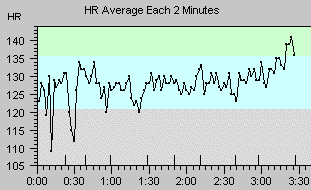 |
EN: endurance |
Some improvement in aerobic capacity, but not as useful as OD and IN.
Not very much training here. |
looks just like OD except at 10 or 15bpm higher HR. |
| IN: intervals |
Increases AT. This allows me to race continuously at higher
intensity for an entire race. Higher intensity means faster. This should
be a good thing.
Example: after a 10 to 20 minute warm-up (not shown) I set the treadmill
to between 5:40 and 5:10 pace for 1 minute. Wait 2 to 3 minutes for
zone 1 HR (<137bpm) before repeating.
There are several variables to interval training. I've chosen a short
peak time so that I can fully recover between each peak and still get quite
a few peaks into a single session. Next year, I may increase to 90 second
peak time, but this year, it seemed best to start "easy". Even so, these
are "hard day" workouts and I try to put "easy days" both before and after
them. |
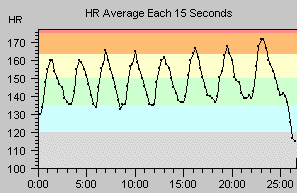 |
UP: hill intervals |
Same physical effects as Interval training. Builds confidence that
race challenges can be overcome.
Example: treadmill at 7:00 pace and 8% incline for 1 minute. Wait 2
to 3 minutes for HR to drop into zone 1. Repeat. I call these my "eighty-eights"
because the peaks are 8 miles per hour (or more) and 8% incline. The recovery
is typically 6.3 mph at -1% grade.
|
looks just like like IN. Hurts like hell, though. |
RP: race pace |
Measure performance at current fitness level.
Example: after warm-up and some speed work, I dial in a 6:40 to 7:00
pace and hold it for 15 minutes. This was my first RP - I plan to increase
the distance to a nice round 5k (about 20 minutes). |
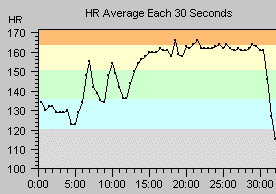 |
Competition |
This is what it's all for, right?
Example: Bridge to Bridge Race 2002. This is a crowded 12k race so I
had a hard time running my pace, but I had a great time anyway. I ran more
than a minute per mile faster and at a lower effort than last year. Cool. |
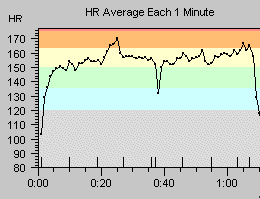 |
SP: speed |
This training teaches me to go fast with minimal effort. In particular,
I should be relaxed, not straining.
Example: this is an old (August?) training run with 6 speed bursts thrown
in. Each burst is only 20 seconds long. The idea is to smoothly and effortlessly
accelerate and then drop back to an easy pace.
Another type of speed work I do is more goal oriented: The speed peaks
are each 1/8 mile and the pace is designed to increase from week to week
so that by the end of the base period I'm practicing race pace speed for
1/8 mile. These are called "Body speeds". Don't ask me why. |
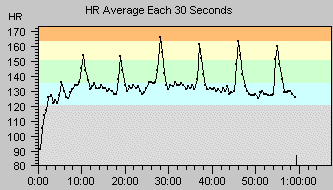 |
Stay tuned for "Training Bob"




